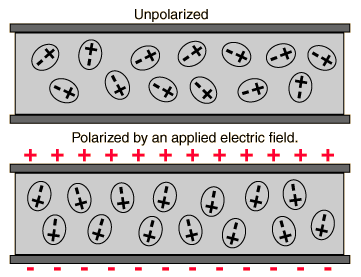We define the dielectric constant as the ratio of the electric flux density in a material to the electric flux density in a vacuum. A material with a high dielectric constant can store more electrical energy than a material with a low dielectric constant. The constant is usually represented by the symbol ε (epsilon).
What Is the Dielectric Constant in Simple Terms?
When we apply an electric field to a material with a high dielectric constant, the electric charges within the material will become polarized. This means the charges align with the direction of the electric field. This polarized state allows the material to store more electrical energy.

How Does the Dielectric Constant Work?
When we apply an electric field to a material, the electrons in the material will become polarized, which means they will align with the direction of the electric field. This polarized state allows the material to store electrical energy in the form of an electric field. The amount of electrical energy that can be stored in a material is related to its dielectric constant.
A material with a high dielectric constant can store more electrical energy than a material with a low dielectric constant. For example, a capacitor with a high-dielectric material between its plates will have a higher capacitance and be able to store more electrical energy than a capacitor with a low-dielectric material between its plates.
The dielectric constant of a material can be affected by various factors such as temperature, frequency and the presence of other materials. For instance, the dielectric constant of a material can change with frequency.
The Dielectric Constant for Common Materials
- Air: 1.0005 - 1.0006 (at room temperature and standard pressure)
- Vacuum: 1 (by definition)
- Water: 78.4 (at 20°C / 68°F)
- Glass: 4 - 10 (depending on the type of glass)
- Teflon: 2.1
Factors Affecting the Dielectric Constant
There are certain factors that can affect the dielectric constant:
- Frequency: The dielectric constant is typically frequency-dependent, with a higher value at lower frequencies and a lower value at higher frequencies. At lower frequencies the molecules have more time to align and polarize while at higher frequencies they do not have enough time to align.
- Temperature: The dielectric constant generally increases with temperature as the increased thermal motion of the molecules in the material leads to more polarization.
- Density: The dielectric constant of a material is inversely proportional to the density of the material. As the density decreases the dielectric constant gets higher.
- Pressure: The dielectric constant of a material is also affected by pressure. As the pressure increases, the dielectric constant decreases.
Why Is the Dielectric Constant Important?
The dielectric constant is an important parameter in many fields of engineering and physics because it affects the performance of many electrical, optical and sensing devices.
In electrical engineering, we use the dielectric constant in the design of capacitors, electrical insulation, antennas and transmission lines. A material with a high dielectric constant will have a higher capacitance and a higher electrical breakdown strength while affecting the radiation pattern and the transmission efficiency of an antenna, not to mention the attenuation of a transmission line.
Dielectric Constant Applications
The dielectric constant has many practical applications, especially in electrical engineering.
Capacitor Design
In the design of capacitors, the dielectric constant of the material we use as the insulator between the capacitor plates will affect the capacitance. A material with a high dielectric constant will allow a capacitor to store more electrical energy than a material with a low dielectric constant.
Electrical Insulation Design
In the design of electrical insulation a material with a high dielectric constant will have a high electrical breakdown strength. This means it can withstand a higher voltage before breaking down and allowing current to flow.
Antennae and Transmission Lines
In the design of antennae and transmission lines, the dielectric constant of a material can affect the radiation pattern and the transmission efficiency of an antenna as well as the attenuation of a transmission line.
Optical and Sensing Devices
In optics, a material with a high dielectric constant will have a high refractive index, which means it can bend light more than a material with a low dielectric constant. Additionally, the dielectric constant is used in many sensing applications, such as in capacitive sensors, dielectric spectroscopy and permittivity imaging.





